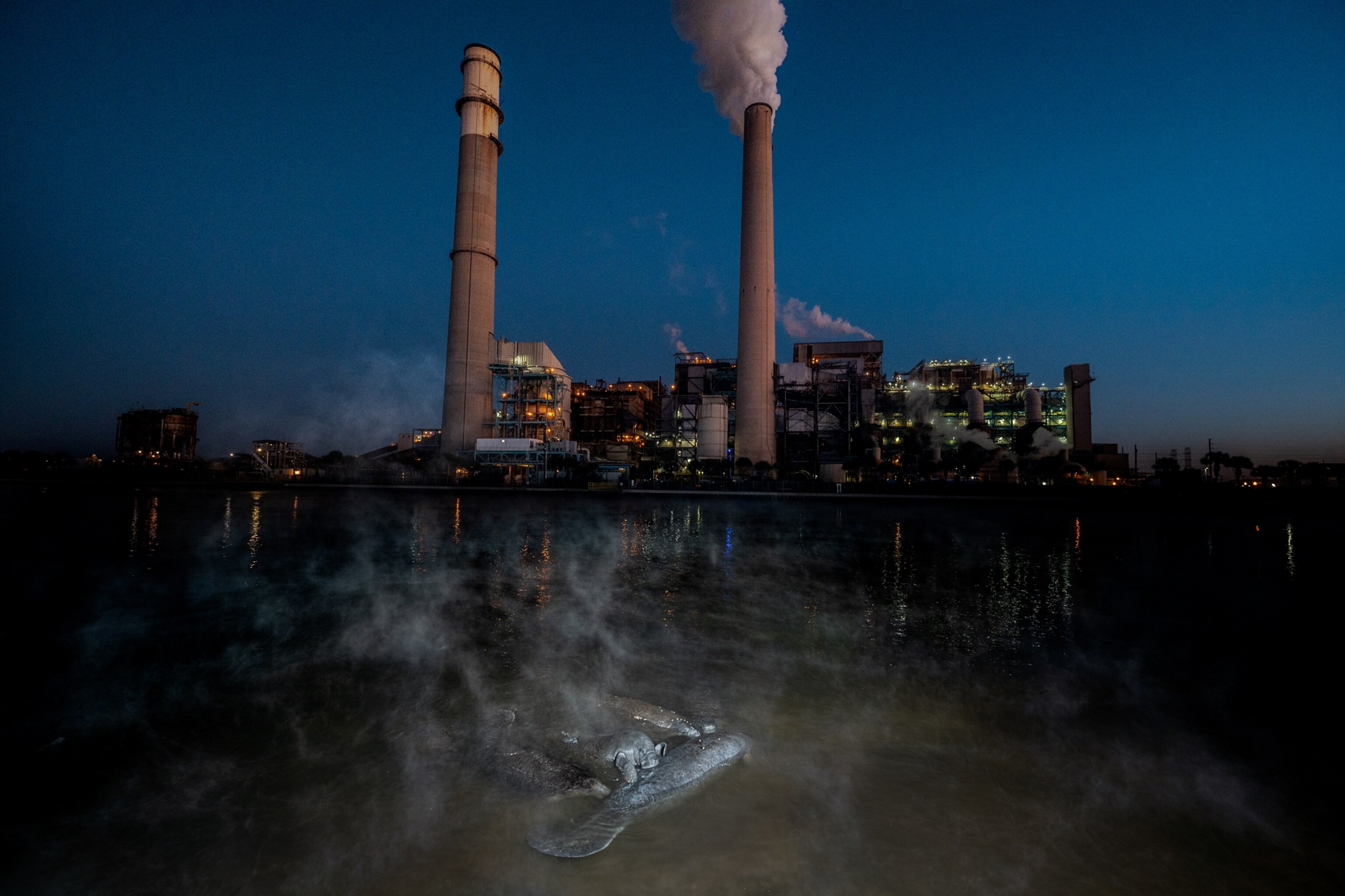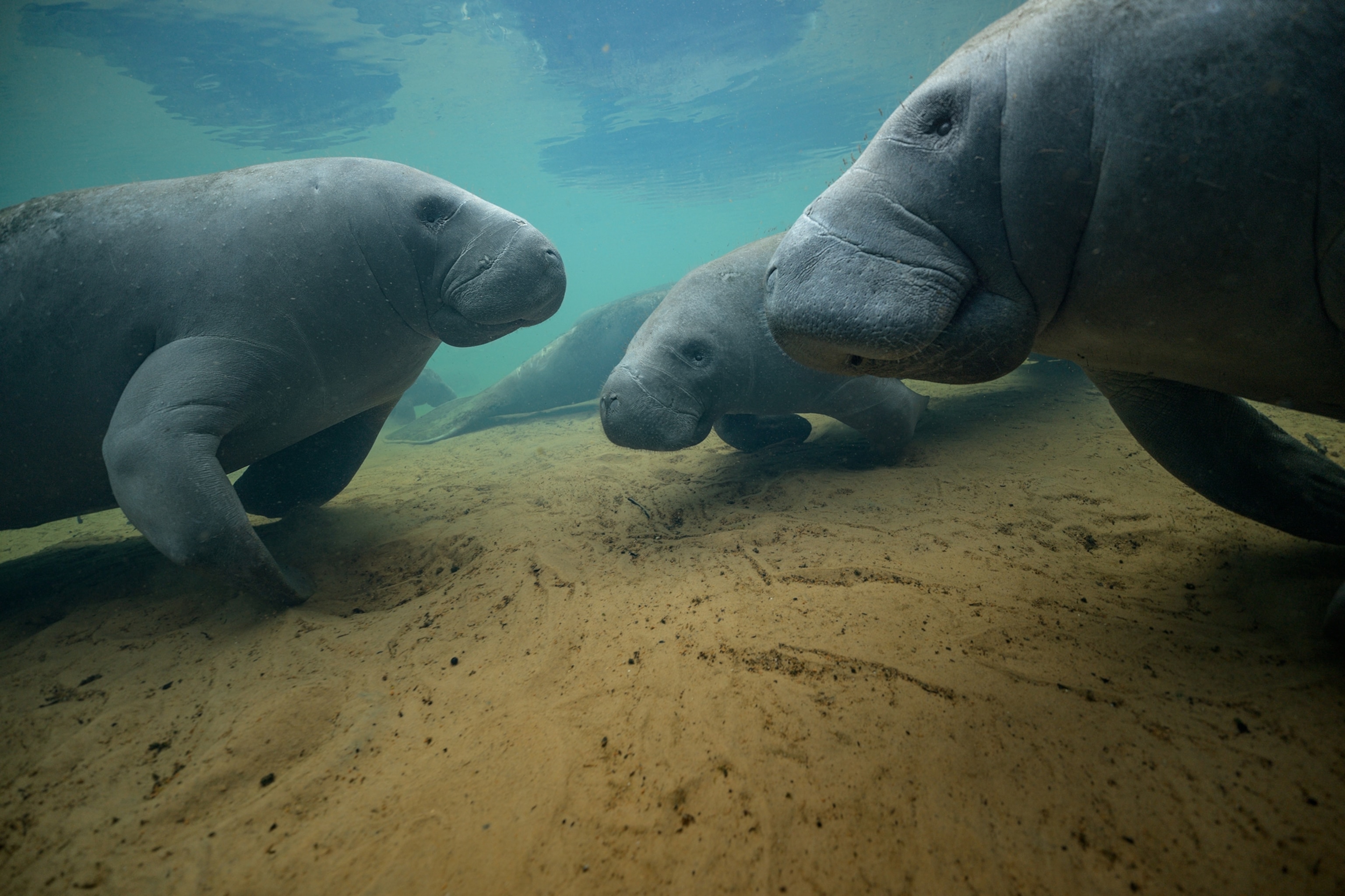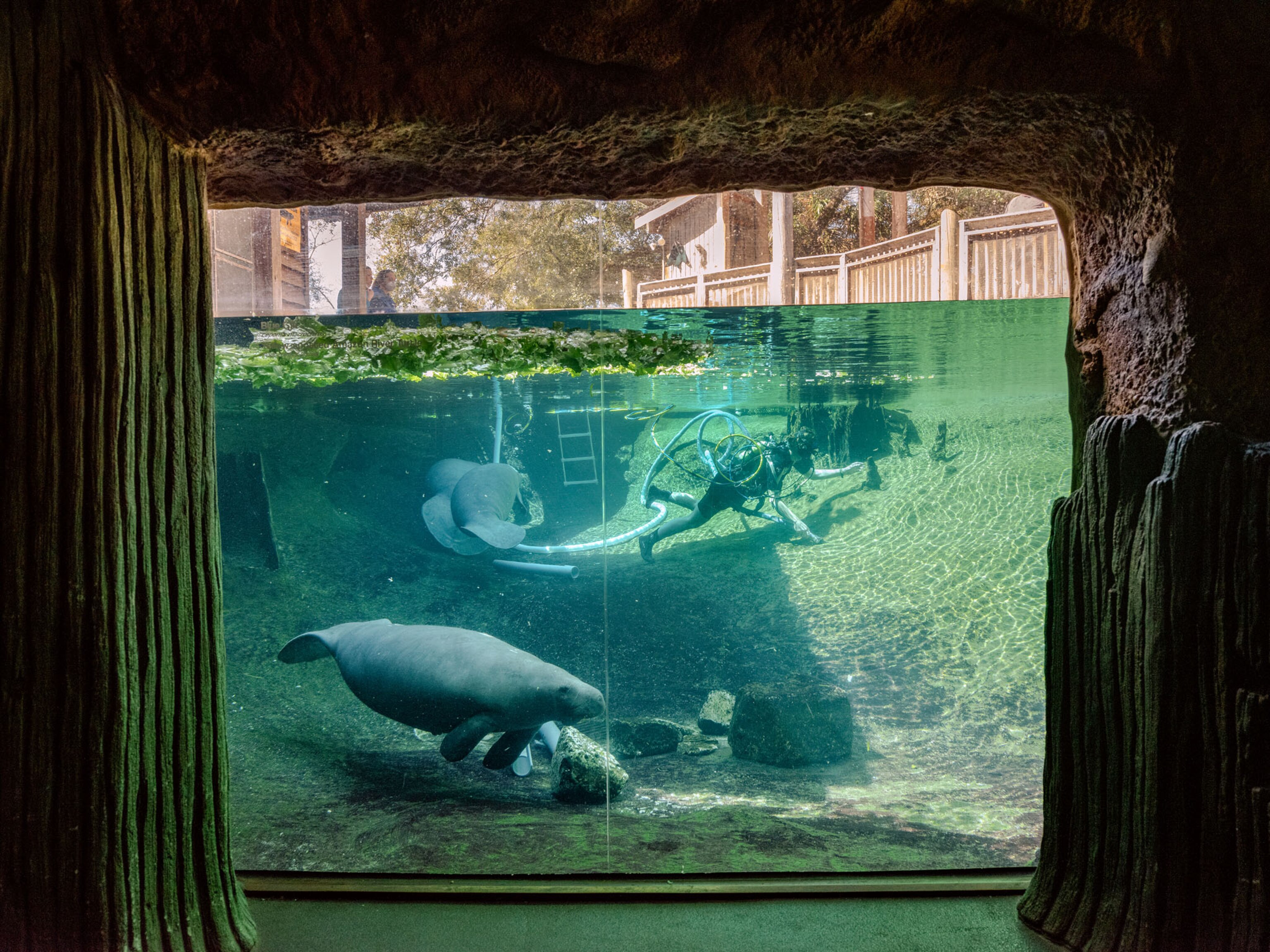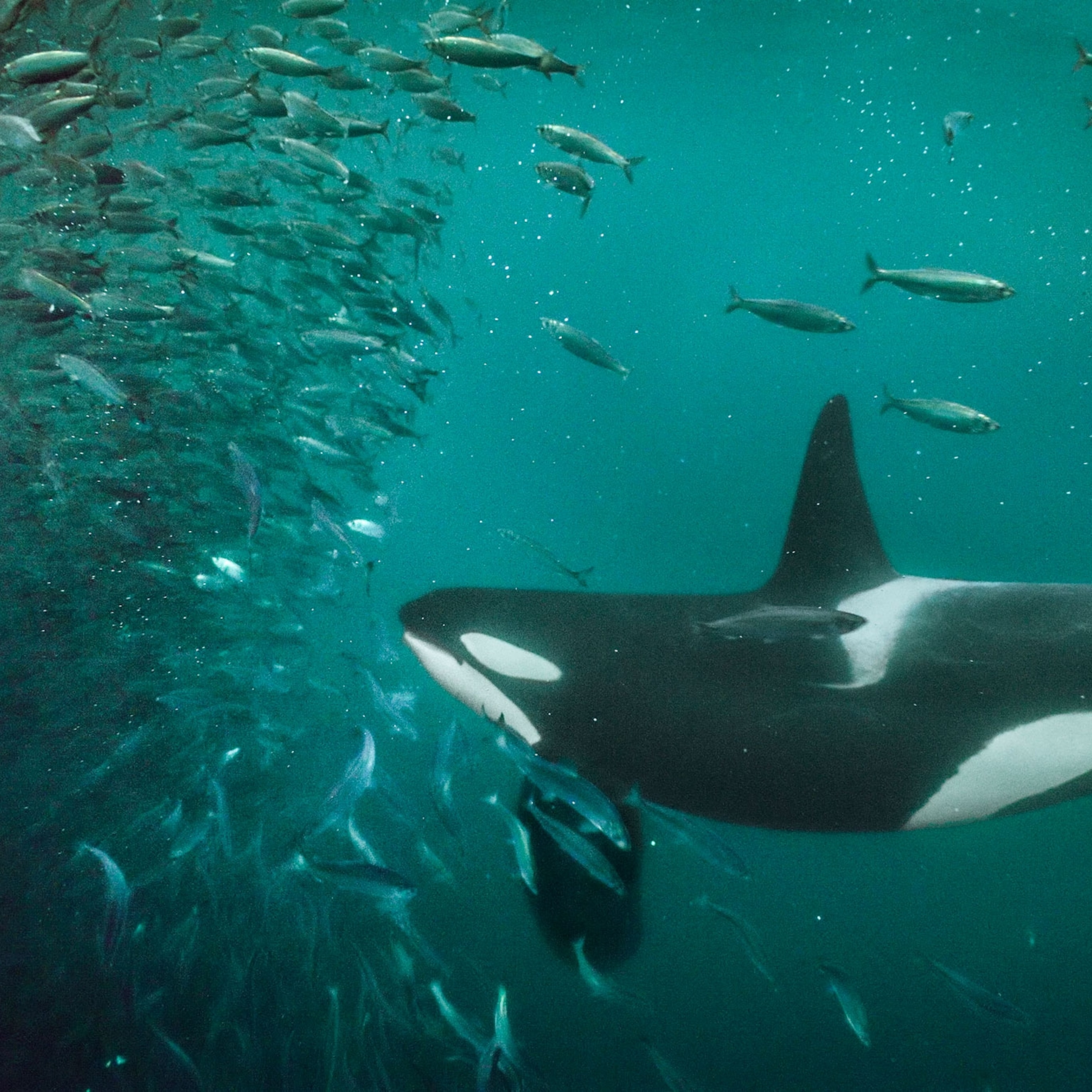
We rallied to save manatees once. Can we do it again?
Decades ago, extinction loomed for these gentle marine mammals in Florida. People helped them rebound—but recent die-offs are a worrying sign.
I wasn’t expecting to invite a stranger into my great-grandmother’s house that afternoon. I’d hoped to interview National Geographic Explorer Buddy Powell on the water in Crystal River, a small town in Florida north of Tampa, where the manatee’s modern-day story begins. But our boat broke down, and it was too hot to hang around the pier to talk. So there we were, sitting across from each other on matching orange sofas in Hazel Gaines’s 1970s-themed living room.
My great-grandmother moved to Crystal River more than 60 years ago; she died in 1993. We’ve kept those sofas because they remind us of her and of our childhood spent exploring the river outside. Buddy Powell is slightly older than the sofas but in far better shape, with youthful posture and alert eyes that kept wandering out toward the water. “It’s a subconscious thing,” he said. “I’ve spent most of my life searching for manatees, and now it’s like my brain is permanently wired with their search image.”

When Powell was growing up here in the 1960s, manatees had all but vanished from Florida. “To find one was very exciting,” he said. One of the world’s foremost experts on these herbivorous marine mammals, he signs his email messages as “James Powell, Ph.D., President and Executive Director of Clearwater Marine Aquarium.” But he always goes by Buddy.


Manatees—often called sea cows—are an anomaly in the animal kingdom. Neither predator nor prey, these peaceable creatures, which can grow to 13 feet and weigh more than 2,000 pounds, are evolutionarily devoid of aggression. They also fall into the class of “charismatic” wild animals that hold humans in their thrall. Their presence in Florida is a reminder of the good humans can do: People have helped them rebound there from under a thousand in the 1960s to more than 7,500 six years ago, based on estimates from aerial surveys, by protecting and restoring manatee habitat, introducing rules to prevent boat collisions, and spreading awareness about these magnificent animals. Crystal River—“Manatee Capital of the World”—is the epicenter of their recovery.
Yet despite the gains, manatees still face grave threats. Three-quarters of Florida’s 22 million people live along the coast, many in prime manatee habitat, where the strain of human presence has degraded the state’s enchanted springs, waterways, and wetlands. In Indian River Lagoon, for example, an important manatee habitat along Florida’s densely populated east coast, decades of human waste, sediment from real estate development, and fertilizers from lawns and farms have clouded the water. That has killed seagrass, manatees’ main food source there. More than a thousand manatees have died in the lagoon during the past two years. As the death toll has risen, facilities that rescue ailing manatees with the hope of returning them to the wild—including ZooTampa at Lowry Park and SeaWorld, in Orlando—have been overwhelmed by an influx of new patients.

Media have framed the manatee die-off as an environmental wake-up call, but Powell puts it this way: “People keep talking about manatees being the canary in the coal mine. But by the time this canary dies, all the miners are already long gone.” In other words, manatee deaths aren’t a signal of forthcoming disaster; their losses are the disaster—the result of warnings long ignored.
The adoption of charismatic animals—such as elephants (manatees’ closest living relative on land), pandas, and dolphins—as conservation symbols can create powerful activism for their protection. In 1978, the Florida Manatee Sanctuary Act designated the state as a “refuge and sanctuary” for manatees, limiting boat speeds in warm-water winter refuges, including Crystal River. The measure bolstered the Marine Mammal Protection Act and the Endangered Species Act, which had become law earlier in the decade.
(See how manatees eat 100 pounds of food a day)
“Everyone is obsessed with them,” says Lisa Smith, a caretaker at ZooTampa’s David A. Straz, Jr. Manatee Critical Care Center. Gift shops in the Sunshine State offer everything from manatee back scratchers and dog leashes to five-foot-tall manatee mailboxes. Members of manatee-themed Facebook groups swap memes and show off manatee arts and crafts. One post offers a rendition of Leonardo da Vinci’s “Last Supper”—but instead of Jesus and his Apostles, it’s manatees seated around the table.
But charismatic animals also can be flashpoints, and manatees have been an intense polarizer: Fervent advocates on one side, and on the other, coastal developers, business interests, and recreational boaters who want unfettered use of Florida’s waters. The divide came to be known as the manatee wars.

What do people find so compelling about an animal that looks like a misshapen blimp and spends its time eating, sleeping, and breaking wind? An answer can be found in the Manatee Tunnel at ZooTampa’s manatee critical care center, a working hospital that can rehabilitate more than 20 of Florida’s signature creatures at once.
It’s dark inside the tunnel, womblike. Whimsical music plays softly in the background. Beyond thick panes of glass, manatees appear to somersault through space like astronauts. Fragments of lettuce catch the light, shimmering like stars. Manatees’ flippers move like a human’s lower arm and are rimmed with fingernails—a 50 million-year-old reminder that their ancestors once walked on land. Wiry hairs on slate gray skin are tactile antennae, giving them an exquisite sense of touch to aid navigation by detecting water movement.
Some spectators, hypnotized by manatees’ incomprehensible, meditative grace, stand in silence. Others murmur about how cute they are. “Is that a walrus?” a man whispers. “No,” his partner replies. “It looks like a giant baked potato.”
Everyone giggles as a manatee swims by and does a barrel roll, releasing a stream of bubbles from her rear end before gliding off with a swoop of the big, paddle-shaped tail. Sea cows, like land cows, are voracious vegetarians and very gassy. The manatee is not as pretty and certainly is “less Hollywood” than the sleek and playful dolphin, wrote Cuban author Manuel Pereira. But, he continued, “all the maternal instinct of the universe is concentrated in this animal.”
Is obsession with manatees enough to ensure their survival in Florida? Only if it goes beyond the gift shop.






“What people don’t understand,” Smith says, “is the need to help support them in waterways.” Above all, that means restoring seagrass beds and freshwater aquatic vegetation, the basis of their existence and of the overall health of Florida’s waters. Seagrass sequesters carbon—“blue carbon”—35 times as fast as tropical rainforests and stores twice as much per acre.
Fed by underground springs, Crystal River mostly lives up to its name. Its electric blue waters are laced with swamps and islands thick with trees festooned by Spanish moss. The air vibrates with the sound of cicadas and carries the sweet scent of marsh mud and salt.
In one of my most vivid childhood memories, from about 1997, I’m standing waist-deep in the water with a snorkel and mask on. My dad has lowered me from the seawall by my wrists and is standing above me, encouraging me to put my face in the water. A creature the size of a small car grazes peacefully a few feet away in the cloudy water. I’m terrified, but I submerge my face anyway. I hear her teeth grinding and feel her enormous presence right beside me.
“The best conservationists are the ones with the most precious childhood memories,” says Powell, who also grew up exploring Crystal River, often in a little rowboat with his father. Only occasionally, he’d catch a glimpse of a large shadow gliding beneath the surface. Not many people understood—or cared—that these ghostly swimmers were among the last surviving manatees in Florida.
Powell’s lifetime fixation seems fated. In 1967, at age 13, he had the chance to assist a graduate student named Daniel Hartman, who was doing the first in-depth study of manatee natural history. Their work, described in the September 1969 issue of National Geographic, introduced manatees to the world. Hartman’s story cautioned readers about the dangers manatees would face as Florida’s population grew. “Pollution has already destroyed the manatee’s food resources in several rivers,” he wrote. “Their future rests entirely in our hands.”

By the time he was 20, Powell had come to know more about the enigmatic manatee than almost anyone else, and the United States Fish and Wildlife Service (FWS) offered him a job with its new manatee research program. He spent the next nine years painting a picture of manatees’ increasingly imperiled existence, not just in Florida but across their range in the southeastern United States. “We traveled from Alabama around to South Carolina interviewing fishermen along the entire coastline,” he says. The research team bought a small plane and hired a pilot, flying over every waterway, searching for manatees. “We would land on remote country highways to pump fuel from the back of a pickup truck before taking off again.”
The information Powell and his team gleaned became the basis of the Florida manatee conservation movement. The Save the Manatee Club led the way, using the manatee’s benign countenance to build an engaged fan base. Groups litigated both for increased regulations that aim to protect the animals and their habitat, and against those who oppose such measures as boating speed limits, restrictions on waterfront development, and the setting aside of areas for manatees.


In 2011, the FWS unveiled a plan to set aside Kings Bay—the roughly 600-acre headwaters area of Crystal River—as a manatee refuge, with a year-round slow-speed rule for boaters. This prompted Steve Lamb, a prominent businessman and philanthropist, and others to form Save Crystal River—to fight back against the “manatee folks.”
“When there’s an endangered species involved, the government can make up rules, and there’s not a damn thing you can do about it,” Lamb says. “They were taking little bites at a time out of our rights.”
The manatee wars culminated in 2012, when the Pacific Legal Foundation petitioned FWS on behalf of Save Crystal River to downlist the animals from endangered to threatened, arguing that their numbers had rebounded. (In 2011, the Florida Fish and Wildlife Conservation Commission had counted 4,834 manatees in the state.) After further review, in 2017 FWS made the controversial decision to downlist manatees. It didn’t change existing protections, but manatee advocates worry that it indicates reduced urgency for a species still very much in need of concerted conservation efforts.
“The decision to downlist the manatee was based on criteria that suggested habitat protections and boat-speed rules had seemed to be effective, allowing manatee populations to rebound,” Powell says. But “we knew there were all these environmental changes beginning to occur—red tide, increasing development in Florida and its impact on waterways, climate change. It’s these bigger environmental and landscape issues that are much more difficult to control,” he says. “They were warned.”
On a chilly January morning, Will Wolfson noses our boat into Mosquito Lagoon, part of the Indian River Lagoon system. Wolfson, a fishing guide with 10 years’ experience on these waters, knows them as if they were an extension of his body. “This whole place is a wasteland,” he says as we skim past a trailer park and into a labyrinth of mangroves. “It’s pretty from above, but below it’s wrecked.”


Indian River Lagoon’s abundant seagrass and sheltered waters have long made it an important habitat for manatees and fish alike. But between 2011 and 2019, more than half the seagrass disappeared. In some places, greater than 90 percent was gone. “Seagrass can no longer grow here,” Wolfson says. “The water’s too murky.”
In 2010, an unusually cold winter killed hundreds of manatees. In the following years, as temperatures warmed and sediment, sewage, and fertilizer runoff continued to flow into the lagoon, algae bloomed out of control, blocking sunlight from reaching plant life. This place used to be thick with seagrass, Wolfson says. “Now I’m on my hands and knees looking for a single blade of grass.”
As seagrass disappeared, Wolfson and other fishermen began educating the public and pressuring state and federal representatives to take action. But seagrass isn’t charismatic. “No one seemed to care until last year, when things hit critical mass, and all these manatees started floating up,” he says. “No one does anything until they hear the m-word,” he adds. “People hear ‘manatee,’ and they start getting jazzed about environmental plight.”
The seagrass calamity in Indian River Lagoon isn’t unique: In the early 2000s, when I was a teenager spending summers at my great-grandmother’s house, algae blooms had transformed this manatee oasis into a festering wasteland. Algae grew into thick, stringy mats that would tangle boat propellers, clog up the vents of underground springs, and block sunlight, which killed any remaining aquatic vegetation. “We were worried about manatees having enough to eat,” Powell recalls.
This horror benefited no one. Kayakers and powerboaters missed the clear water. Anglers missed catching fish. Manatee tour guides and hotel owners worried about how to make a living. Grandparents worried about their grandchildren, who wouldn’t grow up, as they had, exploring the primordial beauty of the place.
Steps to reverse the damage started small. Neighbors gathered with rakes, scooping up algae by hand. Ironically, it was Save Crystal River—the group environmentalists had opposed during their fight over the manatee’s endangered status—that spearheaded the restoration of aquatic vegetation. In confronting the collapse of the place he loved, Steve Lamb shifted his attention toward figuring out how to fix the problem. In 2015, with funding from the state legislature, Save Crystal River hired Sea & Shoreline, an aquatic restoration firm, to remove the muck and replant the river bottom with eelgrass, which grows long, ribbonlike leaves.
The prospect of replanting the entire river was daunting. “People thought we were crazy,” says Lisa Moore, president of Save Crystal River. But after vacuuming more than 300 million pounds of detritus and planting some 350,000 individual eelgrass pods by hand, the groups have flipped the river back to an ecosystem no longer dominated by algae.

“For years and years, there was no food for the manatees,” Lamb says. “Now we have an abundance of this wonderful eelgrass and clean water. They’re having a heyday, and God bless them. This is awesome.”
Instead of spending the few short winter months in Crystal River before heading back out into the Gulf of Mexico to graze, some manatees now linger here year-round, enjoying fat times and boosting the town’s tourism economy. Aerial surveys from January 2022 revealed the highest number of manatees ever recorded in these waters—more than a thousand in Kings Bay alone. The newly restored vegetation also has allowed more animals—fish, blue crabs, snails, and others—to make their way back into Crystal River.
The Environmental Protection Agency calculates it will cost five billion dollars and take 20 to 30 years to reverse Indian River Lagoon’s ecological collapse. The lagoon lies mostly within Republican-majority Brevard County, whose residents voted in 2016 to adopt a voluntary sales tax that will provide nearly $500 million over 10 years for wastewater infrastructure projects and aquatic restoration. “Anytime you get a Florida county to tax themselves purposely—and that’s a red county too—that’s a win for the environment,” says Carter Henne, lead biologist and president of Sea & Shoreline. Meanwhile, bipartisan legislation is fast-tracking state funding for manatee rescue and rehabilitation, as well as for projects to address the problems that have killed seagrass.

Homeowners in some counties are supplementing money from grants with their own cash to convert leaky septic tanks to mainline sewer systems. In other counties, communities are pushing to restore seagrass and dredge rivers to remove loads of nitrogen and phosphorus trapped on the bottom.
William Bunch—a Crystal River restaurant owner, community leader, and family friend—met my great-grandmother in the 1960s when he was a teenager running a landscaping business. “I remember back then, your great-grandmother refused to let us put fertilizer on her lawn,” he says with a laugh. “Your grandmother was the same. They didn’t want any of that stuff washing out into the river.”
Today homeowners and businesses are embracing Florida-Friendly Landscaping guidelines, part of an extension program to reduce water and fertilizer use. And increasingly, sugarcane, vegetable, and rice farmers—among the major contributors of nutrients that fuel algae blooms—are adopting voluntary, science-based “nutrient stewardship programs” to reduce their industry’s impact on water quality.
“We’re not the bad guys,” says Eric Hopkins, a third-generation vegetable and sugarcane grower in Palm Beach County, about 25 miles from Indian River Lagoon. “Everybody plays a part in messing things up, and everyone can play a part in fixing things.” In 2021, Hopkins says, farmers in his area reduced phosphorus, a leading pollutant, by 59 percent—more than twice what was required by law. Adopting nutrient-stewardship techniques saves farmers money, Hopkins says. But most important, it’s “the right thing to do. If we don’t maintain the viability of our land, we’re just putting ourselves out of business.”

Betty Osceola—an educator, conservationist, and clean-water advocate who grew up in Florida’s Everglades—is a member of the Miccosukee Tribe. She says her mother and grandmother would tell stories about seeing manatees deep within the heart of the “river of grass.”
Now, roads and levees block them from swimming so far inland. “There has to be a mind shift,” Osceola says. “If you think about healing the water body, about healing the land, you’ll see much more improvement versus managing, eradicating.”
Part of the shift, she says, is for more people to understand that we’re within a living system where manatees, plant life, and all of us are interconnected. “I can’t speak for other Indigenous people, but from my upbringing, we’re always taught to look at everything around you as your relative,” she says. “You’re a part of that. We all have our place and our purpose, and we all have to help foster life for each other.”
As calves, manatees learn survival skills from their mothers. Humans aren’t so different. When I was growing up, my parents took us to Crystal River to spend time with our grandparents, who taught us about the world we were inheriting. After dinner, we’d sit outside, watching the heat lightning flicker in the distance and listening to the music of frogs and insects drift across the water. Sometimes another sound would jolt us to attention: Pffff!—a manatee coming up for air.

The National Geographic Society is committed to illuminating and protecting the wonder of our world. Learn more about the Society’s support of its Explorers.
You May Also Like
Go Further
Animals
- Octopuses have a lot of secrets. Can you guess 8 of them?
- Animals
- Feature
Octopuses have a lot of secrets. Can you guess 8 of them? - This biologist and her rescue dog help protect bears in the AndesThis biologist and her rescue dog help protect bears in the Andes
- An octopus invited this writer into her tank—and her secret worldAn octopus invited this writer into her tank—and her secret world
- Peace-loving bonobos are more aggressive than we thoughtPeace-loving bonobos are more aggressive than we thought
Environment
- This ancient society tried to stop El Niño—with child sacrificeThis ancient society tried to stop El Niño—with child sacrifice
- U.S. plans to clean its drinking water. What does that mean?U.S. plans to clean its drinking water. What does that mean?
- Food systems: supporting the triangle of food security, Video Story
- Paid Content
Food systems: supporting the triangle of food security - Will we ever solve the mystery of the Mima mounds?Will we ever solve the mystery of the Mima mounds?
- Are synthetic diamonds really better for the planet?Are synthetic diamonds really better for the planet?
- This year's cherry blossom peak bloom was a warning signThis year's cherry blossom peak bloom was a warning sign
History & Culture
- Strange clues in a Maya temple reveal a fiery political dramaStrange clues in a Maya temple reveal a fiery political drama
- How technology is revealing secrets in these ancient scrollsHow technology is revealing secrets in these ancient scrolls
- Pilgrimages aren’t just spiritual anymore. They’re a workout.Pilgrimages aren’t just spiritual anymore. They’re a workout.
- This ancient society tried to stop El Niño—with child sacrificeThis ancient society tried to stop El Niño—with child sacrifice
- This ancient cure was just revived in a lab. Does it work?This ancient cure was just revived in a lab. Does it work?
- See how ancient Indigenous artists left their markSee how ancient Indigenous artists left their mark
Science
- Jupiter’s volcanic moon Io has been erupting for billions of yearsJupiter’s volcanic moon Io has been erupting for billions of years
- This 80-foot-long sea monster was the killer whale of its timeThis 80-foot-long sea monster was the killer whale of its time
- Every 80 years, this star appears in the sky—and it’s almost timeEvery 80 years, this star appears in the sky—and it’s almost time
- How do you create your own ‘Blue Zone’? Here are 6 tipsHow do you create your own ‘Blue Zone’? Here are 6 tips
- Why outdoor adventure is important for women as they ageWhy outdoor adventure is important for women as they age
Travel
- This royal city lies in the shadow of Kuala LumpurThis royal city lies in the shadow of Kuala Lumpur
- This author tells the story of crypto-trading Mongolian nomadsThis author tells the story of crypto-trading Mongolian nomads
- Slow-roasted meats and fluffy dumplings in the Czech capitalSlow-roasted meats and fluffy dumplings in the Czech capital






